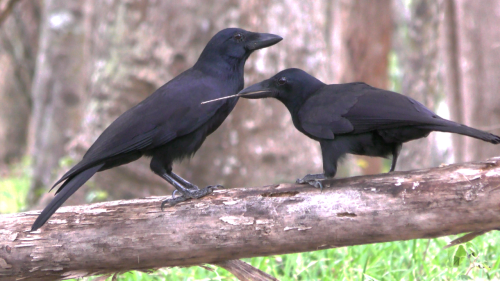We-are-all-paranoid - Microbe Nerd Alert

More Posts from We-are-all-paranoid and Others

fruitie punches

Think of others. Think of the vulnerable.
Slime Molds and Intelligence

Okay, despite going into a biology related field, I only just learned about slime molds, and hang on, because it gets WILD.
This guy in the picture is called Physarum polycephalum, one of the more commonly studied types of slime mold. It was originally thought to be a fungus, though we now know it to actually be a type of protist (a sort of catch-all group for any eukaryotic organism that isn't a plant, animal, or a fungus). As protists go, it's pretty smart. It is very good at finding the most efficient way to get to a food source, or multiple food sources. In fact, placing a slime mold on a map with food sources at all of the major cities can give a pretty good idea of an efficient transportation system. Here is a slime mold growing over a map of Tokyo compared to the actual Tokyo railway system:

Pretty good, right? Though they don't have eyes, ears, or noses, the slime molds are able to sense objects at a distance kind of like a spider using tiny differences in tension and vibrations to sense a fly caught in its web. Instead of a spiderweb, though, this organism relies on proteins called TRP channels. The slime mold can then make decisions about where it wants to grow. In one experiment, a slime mold was put in a petri dish with one glass disk on one side and 3 glass disks on the other side. Even though the disks weren't a food source, the slime mold chose to grow towards and investigate the side with 3 disks over 70% of the time.

Even more impressive is that these organisms have some sense of time. If you blow cold air on them every hour on the hour, they'll start to shrink away in anticipation when before the air hits after only 3 hours.
Now, I hear you say, this is cool and all, but like, I can do all those things too. The slime mold isn't special...
To which I would like to point out that you have a significant advantage over the slime mold, seeing as you have a brain.
Yeah, these protists can accomplish all of the things I just talked about, and they just... don't have any sort of neural architecture whatsoever? They don't even have brain cells, let alone the structures that should allow them to process sensory information and make decisions because of it. Nothing that should give them a sense of time. Scientists literally have no idea how this thing is able to "think'. But however it does, it is sure to be a form of cognition that is completely and utterly different from anything that we're familiar with.

The zebrafish is used as model in developmental biology. Here two juvenile fish of just two days old. © MPI für Entwicklungsbiologie/ Jürgen Berger/ Mahendra Sonawane
via Frans de Waal - Public Page http://ift.tt/105kgEA
To students taking exams right now:
You are smarter than you know
It is almost over, just keep holding on
You are not your grades, and your grades don’t define your intelligence
Trust and believe in yourself
Stop comparing yourself to others
Remember to drink water (not just coffee)

Stop the ban on blood donation of gay men

Like humans, these big-brained birds may owe their smarts to long childhoods
Human beings typically don’t leave the nest until well into our teenage years—a relatively rare strategy among animals. But corvids—a group of birds that includes jays, ravens, and crows—also spend a lot of time under their parents’ wings. Now, in a parallel to humans, researchers have found that ongoing tutelage by patient parents may explain how corvids have managed to achieve their smarts.

vitamin sea, if you will
Reminder to Click for Palestine today!
Click for the other causes as well if you can!
-
 halloween-profane liked this · 1 year ago
halloween-profane liked this · 1 year ago -
 ruby-tuessdaay reblogged this · 1 year ago
ruby-tuessdaay reblogged this · 1 year ago -
 kiwi-collideoscope reblogged this · 2 years ago
kiwi-collideoscope reblogged this · 2 years ago -
 coolcalmcollector-blog reblogged this · 2 years ago
coolcalmcollector-blog reblogged this · 2 years ago -
 lyliah7 liked this · 2 years ago
lyliah7 liked this · 2 years ago -
 valleynausicaa reblogged this · 2 years ago
valleynausicaa reblogged this · 2 years ago -
 not-lex-luthor liked this · 2 years ago
not-lex-luthor liked this · 2 years ago -
 angrycornpeople reblogged this · 2 years ago
angrycornpeople reblogged this · 2 years ago -
 fancysaurus liked this · 2 years ago
fancysaurus liked this · 2 years ago -
 montmorillionite reblogged this · 2 years ago
montmorillionite reblogged this · 2 years ago -
 montmorillionite liked this · 2 years ago
montmorillionite liked this · 2 years ago -
 snarkystenonychosaurus reblogged this · 2 years ago
snarkystenonychosaurus reblogged this · 2 years ago -
 tiberiusmulder reblogged this · 2 years ago
tiberiusmulder reblogged this · 2 years ago -
 happinessisaloadedgun reblogged this · 2 years ago
happinessisaloadedgun reblogged this · 2 years ago -
 happinessisaloadedgun liked this · 2 years ago
happinessisaloadedgun liked this · 2 years ago -
 angrycornpeople liked this · 2 years ago
angrycornpeople liked this · 2 years ago -
 toomuchcoffeebye reblogged this · 2 years ago
toomuchcoffeebye reblogged this · 2 years ago -
 toomuchcoffeebye liked this · 2 years ago
toomuchcoffeebye liked this · 2 years ago -
 jamiehascateyes reblogged this · 2 years ago
jamiehascateyes reblogged this · 2 years ago -
 wankydoo liked this · 2 years ago
wankydoo liked this · 2 years ago -
 spiritualsoap liked this · 2 years ago
spiritualsoap liked this · 2 years ago -
 definately-not-a-cat reblogged this · 2 years ago
definately-not-a-cat reblogged this · 2 years ago -
 arandombin liked this · 2 years ago
arandombin liked this · 2 years ago -
 icepick-jackalope reblogged this · 2 years ago
icepick-jackalope reblogged this · 2 years ago -
 lumacafilosophica liked this · 2 years ago
lumacafilosophica liked this · 2 years ago -
 bcsterling liked this · 2 years ago
bcsterling liked this · 2 years ago -
 xxvanilla-thundaxx reblogged this · 2 years ago
xxvanilla-thundaxx reblogged this · 2 years ago -
 megamarine reblogged this · 2 years ago
megamarine reblogged this · 2 years ago -
 megamarine liked this · 2 years ago
megamarine liked this · 2 years ago -
 hobo-rg reblogged this · 2 years ago
hobo-rg reblogged this · 2 years ago -
 dameamaryllis liked this · 2 years ago
dameamaryllis liked this · 2 years ago -
 piruriez reblogged this · 2 years ago
piruriez reblogged this · 2 years ago -
 piruriez liked this · 2 years ago
piruriez liked this · 2 years ago -
 breaks-hetheon liked this · 2 years ago
breaks-hetheon liked this · 2 years ago -
 ca1iban liked this · 2 years ago
ca1iban liked this · 2 years ago -
 crossroadofinterests reblogged this · 2 years ago
crossroadofinterests reblogged this · 2 years ago -
 asklunakittywolf liked this · 2 years ago
asklunakittywolf liked this · 2 years ago -
 morskijez00 reblogged this · 2 years ago
morskijez00 reblogged this · 2 years ago -
 morskijez00 liked this · 2 years ago
morskijez00 liked this · 2 years ago -
 videogamesandnotmuchelse liked this · 2 years ago
videogamesandnotmuchelse liked this · 2 years ago -
 apologeticallyfat reblogged this · 2 years ago
apologeticallyfat reblogged this · 2 years ago -
 tiberiusmulder liked this · 2 years ago
tiberiusmulder liked this · 2 years ago -
 fivequartersoftheorange reblogged this · 2 years ago
fivequartersoftheorange reblogged this · 2 years ago -
 danelloevee reblogged this · 2 years ago
danelloevee reblogged this · 2 years ago -
 danelloevee liked this · 2 years ago
danelloevee liked this · 2 years ago -
 vwildmonk reblogged this · 2 years ago
vwildmonk reblogged this · 2 years ago -
 firlefanzerin liked this · 2 years ago
firlefanzerin liked this · 2 years ago -
 ms-pizza reblogged this · 2 years ago
ms-pizza reblogged this · 2 years ago

